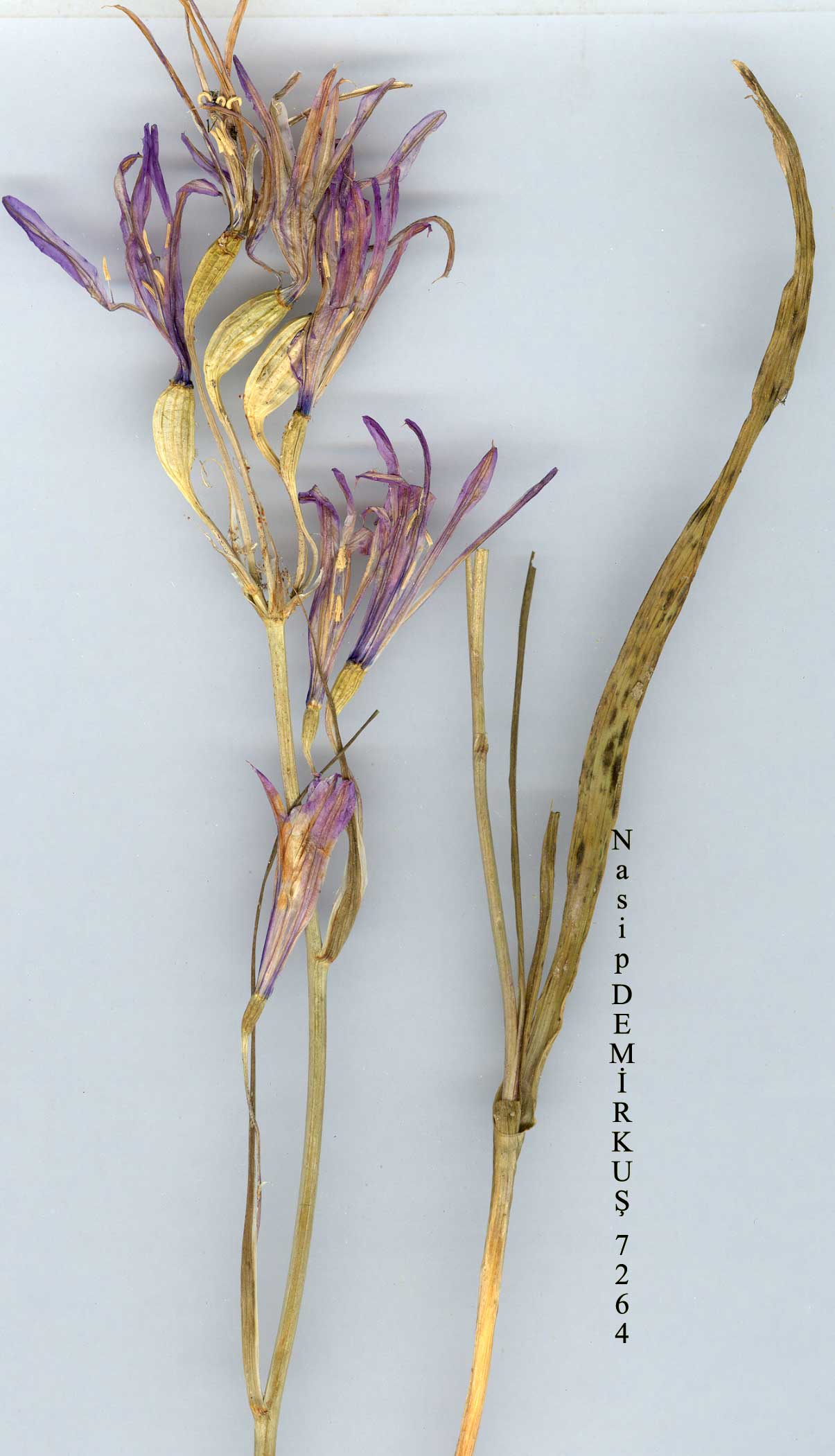| Amaryllidaceae |
|---|
Ixiolirion FISCHER EX HERBERT |
| I.tataricum (Pallas) Herbert in Bot. Reg. 7: App. 37 (1821). Bulb ovoid or ovoid-oblong, 1-1.5 cm diam. Basal leaves linear, 13-37 cm x 1-15 mm, with scabrid margins. Scape 20-45 cm. Flowers 2-8 in umbel, with (0-)l-4 below (in simple racemes). Perianth segments blue or violet-blue (in Turkey), with 3 dark raised lines running down the often paler middle, 20-50 x 2.3-6.5 mm; apex of outer ones with 0.5-4 mm apiculus; apiculus of inner segments very short or absent. Anthers 1.5-5.5 mm, curved or straight at apex. Style at first equalling shorter stamens, lengthening to become ± equal to longer stamens at maturity. 1. Anthers oblong-linear, 2.6-5.5 mm, tapering to usually curved apex,(4-)5-8 x as long as broad subsp. montanum 1. Anthers ovoid, 1.5-2.5 mm, broadest near middle, ± straight, 2-3 x as long as broad subsp. tataiicum subsp. montanum (Labili.) Takht. in Takht. & Fed., Fl. Erevana ed. 2:329 (1972). Syn: Amaryllis montane Labili,, Ic PL Syr. Rar. Dec. 2:5,t. i (1791)! Ixiolirion montanum (Labill) Herbert is Bot. Reg. 7: App. 37 (1821)! I. palasii auct. «on Fiseb. & Mey. ex Ledeb. (1853). Ic: Bot. Reg. 30: t 66 (1844), as/. montsnum;nehmé,Fls,Sauv.libant.42(1980),as/. tataricum. Fl 4-6, Rocky! calcareous slopes, corn-and fallow fields, vineyards, roadsides, 500-2500 m. Type: [Lebanon] in, altis montibus Libasa, Labillardiere (holo. P, iso. K!). Mainly E. Anatolia. Bβ Kayseri: 8 km from Sariz to Pinarhisar, 1850 m, A. Baytop (ISTE 40139}! B7 Erzincan: Eğin (Kemaliye), Sint. 1890:2650 (var. grandifloram Freyn & Sint,)! §9 Bitlis: 6 km S. of Bitlis, 1350 m, D. 43062! BIO Van: 4 km from Özalp to Saray, 2200 m, D. 44386! C5 Adana/Niğde: Cilicîan Tatıras, vi 1874, danford! C6 Gaziantep: Düllük Baba nr Gaziantep, 1220. m, Haradj. 1179! C7 Adıyaman: 25 km E. of Kahta, 700 m, Sorger 80-27-50? C8 Mardin: 18-19 km from Mardin to Savur, D. 28536! C9 Siirt: above Şirnak, 1400-1500 m, D. 42620! C10 Hakkari: VadinasorTepe, 22km N.W. of Yüksekova, 2500 -a, Watson 5623! Lebanon, Palestine, Syrian Desert, N. Iraq, N.W. & W. Iran, C, Asia (Song-aria). ir.-Tur. element. Mors northerly in distribution than subsp. iataricum but sometimes sympatric with the latter. Very variable in perianth segment colour and length, anther length and in the form of the inflorescence; like subsp. tataricum, it is fragmented into local populations which are often quite distinct (e.g. nar. grandi/lorum Freyn & Sint.) but as every possible intergrad-ation occurs these are not given recognition. Specimens from B10 Ağri (Doğub-ayazit, Î6İ5 m, D.M. Brown 470!) and CIO Hakkari (Watson 5623!) differ more significantly from the others in their somewhat broader anthers 4 x as long as broad. A specimen from 'Smyrna" [Bl Izmir] 'from a hitherto untapped and very wild region,' comia. Whittail 30 ix 1903 (K!) is certainly wrongly localised;it may have originated from the Cilician Taurus. Distribution of species: S.W.. &. C. Asia E. to Tien Shan and Kashmir. Subsp. ledebourii (Fisch. & Mey,) R, Mill, slat. nov. [Syn: /. ledebourii Fisch. & Mey. in Bong. & Mey,, SuppL Fl. Alt. no. 293 (1841)] is restricted to the Altai. |
 HERBERT subsp_ montanum (LABILL_) TAKHT _jpg.jpg)
 HERBERT subsp_ montanum (LABILL_) TAKHT _jpg.jpg)
 HERBERT subsp_ montanum (LABILL_) TAKHT _jpg.jpg)
 HERBERT subsp_ montanum (LABILL_) TAKHT _jpg.jpg)
 HERBERT subsp_ montanum (LABILL_) TAKHT_jpg.jpg)
